RECOIL OFFGRID Survival Tiga Tactics Knife Defense Seminar: Alertness and Survival in San Francisco
In This Article
What would you do if you were forced to face off against an aggressive stranger bent on attacking you with a knife? Depending on your level of experience, that terrifying scenario could induce one of the three most common reactions to a life threatening situation: fight, flight or freeze. Locking up with fear is clearly the worst reaction. Not being in that situation to begin with is ultimately the best option, with getting away as fast as possible a close second. But if you had no choice but to fight, is there a way to do so without getting sliced to ribbons? Tiga Tactics, a self-defense and consulting company with over 60 years of combined martial arts experience has several effective answers to knife defense, and we attended their Knife Defense Seminar in San Francisco to learn more.
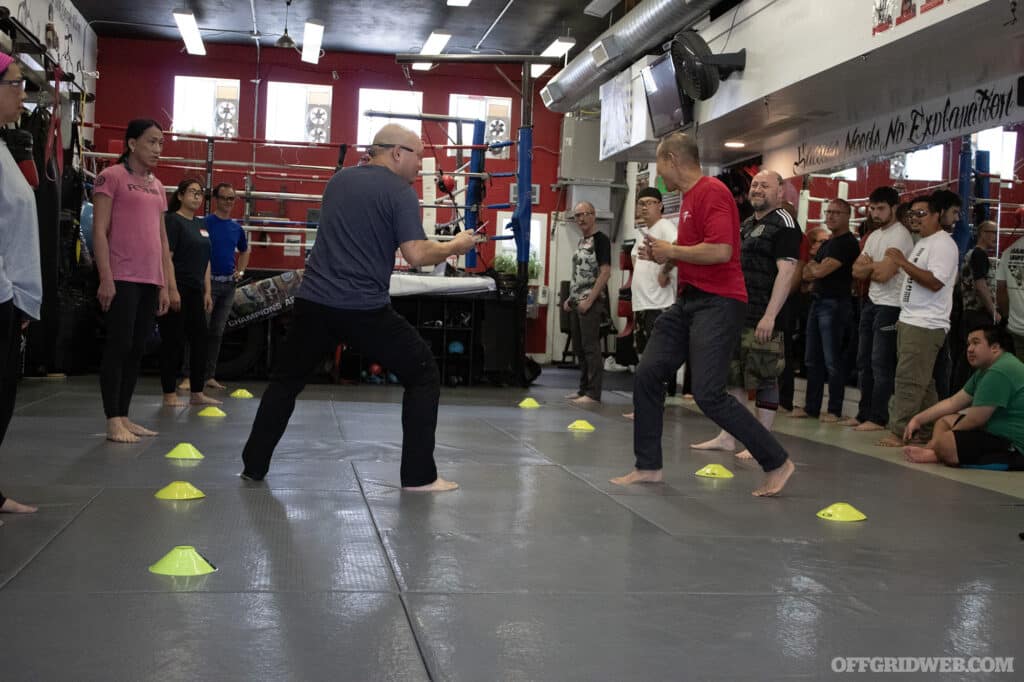
Above: Instructors Dr. Conrad Bui and Patrick Vuong demonstrate knife defense techniques.
Our adventure into the world of knife defense kicked off with some easy to learn fighting stances and simple strikes. We jumped headfirst into the basics, the nitty-gritty details that form the groundwork of practical self-defense techniques that could be your lifeline in sticky situations. These techniques were derived after studying over a thousand hours of real-world knife attacks and picking out the most common patterns that emerged. In the murky world of street fights, even through the chaos and adrenaline, they often encompass four primal types of attacks: knife attacks, hooks, bludgeoning weapons, or even firearms. Recognizing these is like acquiring a secret decoder to untangle the mess in real-time. When it comes to knife attacks, the two most common movements the aggressors make are the underhand thrust, also known as the “sewing machine,” and the overhand swing, fondly known as the “psycho stab.”
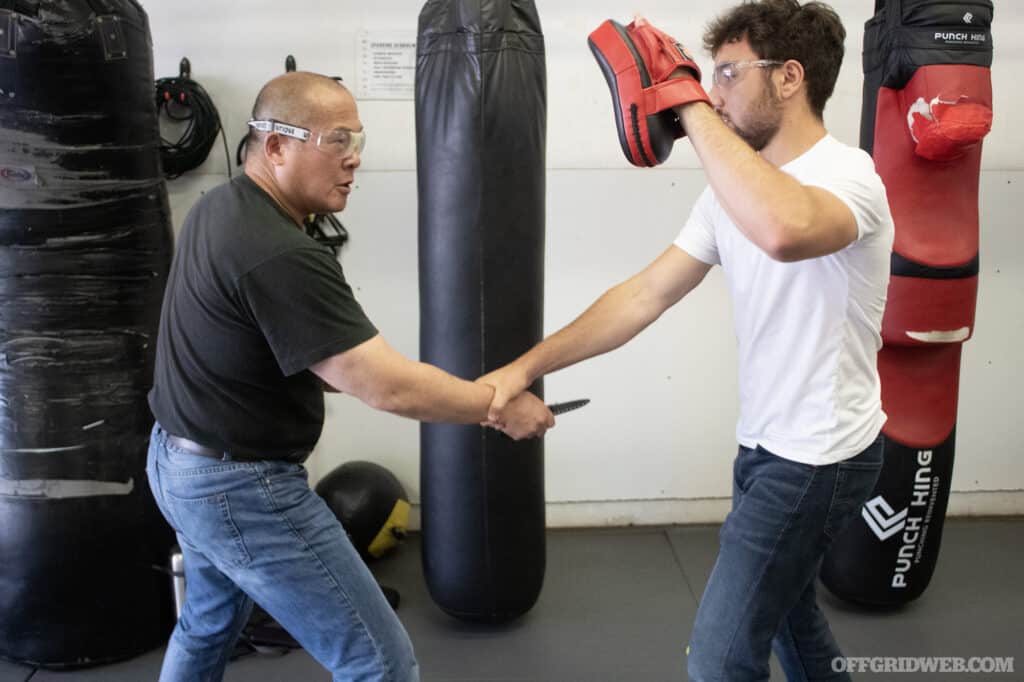
Above: Assistant instructor Sherman Chin demonstrates how to break free from a simulated aggressor trying to halt his offensive strike.
Since the focus of the seminar is on knife attacks, we quickly learn some of the most efficient defensive and offensive physical reactions to this type of assault.

Hand stance: It all begins with the hand stance. Imagine something is being thrown at your head, your first reaction will most likely be to cover your face to prevent your eyes, nose and ears from being damaged. This is a natural instinct ingrained into all of us to protect our biological sensory inputs. We can also use this initial reaction to get ourselves in an optimized position to both defend and counter attack an aggressor. Hands held high, not to cower in fear, but to set up a defensive fortress close to your head. This isn't just defense—it's a poised tiger, ready to strike when the moment demands.
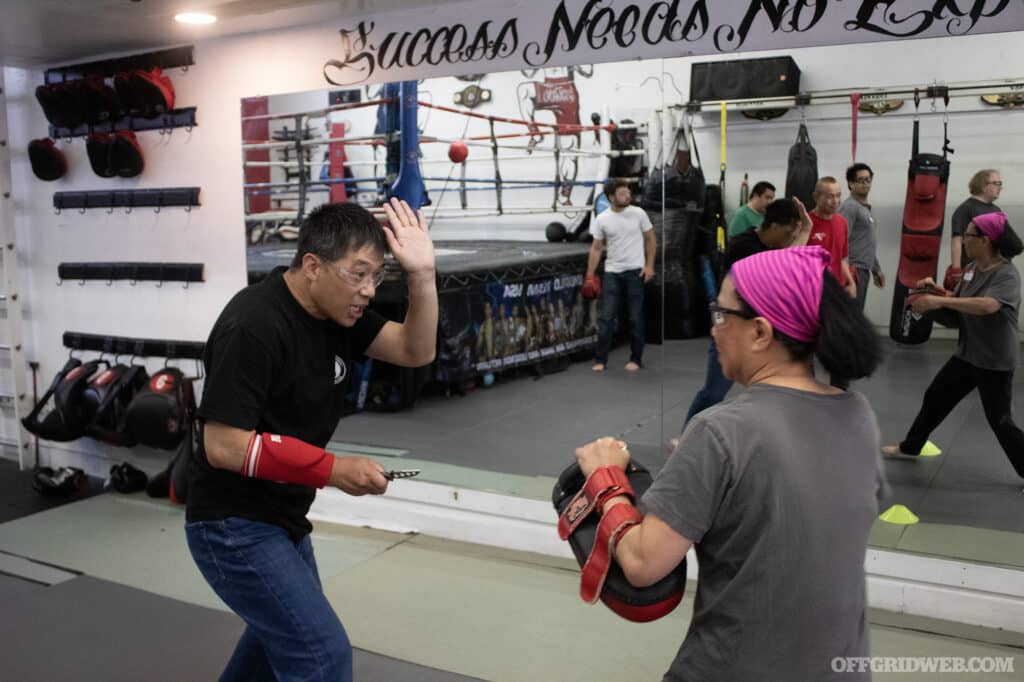
Above: One-by-one, each seminar attendee faces off against everyone in their group, pushing their newly learned skills to the limit.
Strikes: We then switched gears, throwing ourselves into the whirlwind of strikes. Our repertoire expanded with palm strikes, loose-fingered finger washes that target our attackers eyes, precise elbow strikes—taking care not to overextend our reach, throwing off our balance—and powerhouse knee strikes. The heel of the palm is used instead of punching with a closed fist to prevent damage to your knuckles. When in the midst of a knife defense situation, the last thing you want is to be crippled with pain because your counter attack broke a finger or shattered a bone.
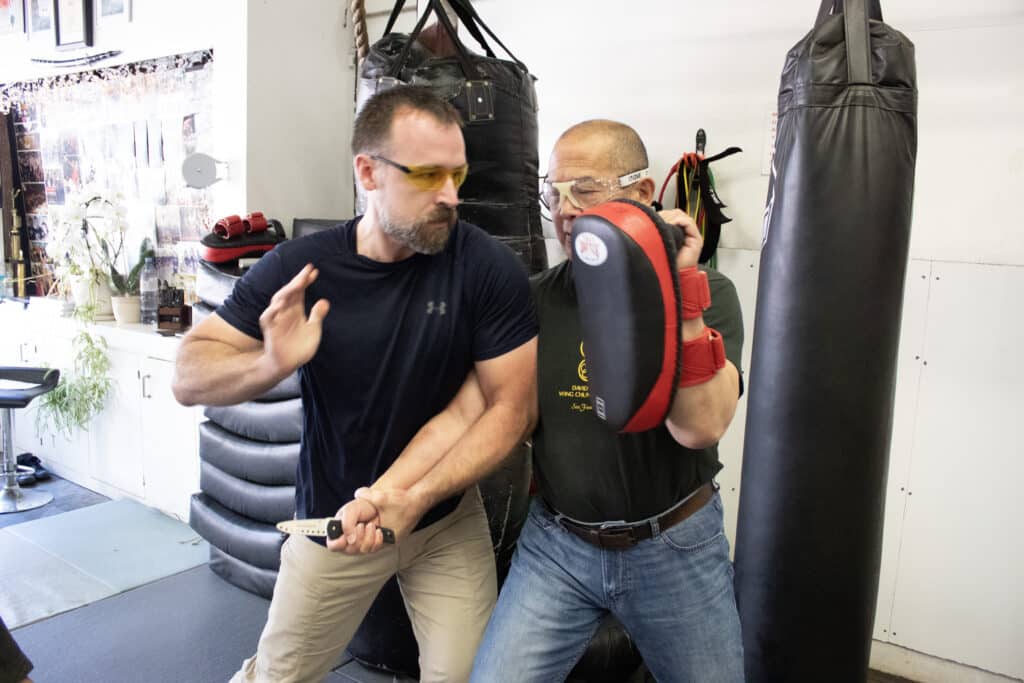
Above: The palm strike prevents broken hand bones and bruised knuckles.
Surviving a sudden showdown isn't just about how hard you can hit—it's often about your tiger-like situational awareness. Using environmental cues, such as a random car honk or a bing from your phone, you can pull up your mental drawbridge, steady your breathing, and crank up your surroundings' observance. Often when potential assailants look for targets, they are looking for people who are clearly not paying attention to their surroundings. This could be someone who's head never leaves the screen of their phones, people who are lost in a podcast being played through ear buds, or even someone standing with bad posture. Simply standing up straight and giving the appearance that you are aware of your surroundings can be enough to stop a bad actor from selecting you as a target. Our instructors also made a point to remind us that this isn't just about feeding your inner paranoia. It's also about spotting the beautiful details life splashes around us.

Above: These days, people spend a lot of time looking at phones. This makes them ideal targets for potential assailants.
Diving into the realm of knife attacks, remember: most folks with a knife are scared, confused, often with little to zero training. Even though they are the ones with the intent to harm another with a blade, their biological systems are probably surging with catecholamines like adrenaline, making it hard to think rationally. This is why they resort to one of the two easiest to carry out attack motions, the sewing machine, or the psycho stab. To effectively defend against these moves we are taught the secret sauce acronym, PRO (Protect. Reposition. Offense).
Protection: Safety first. Before you can launch into your own counter attack, you need to make sure that the sharp end of a knife isn't free to harm you. To do this, we practice an easy to learn blocking technique that once again, draws on your natural instinct to shield yourself. Imagine what your first physical reaction would be if someone with a knife is coming at you, and they swing. Chances are likely you will try to block the swing with your closest forearm. But you can take this a step further by using your second arm to create an “X” shape, temporarily trapping your assailants knife wielding hand in the top of the “X”.
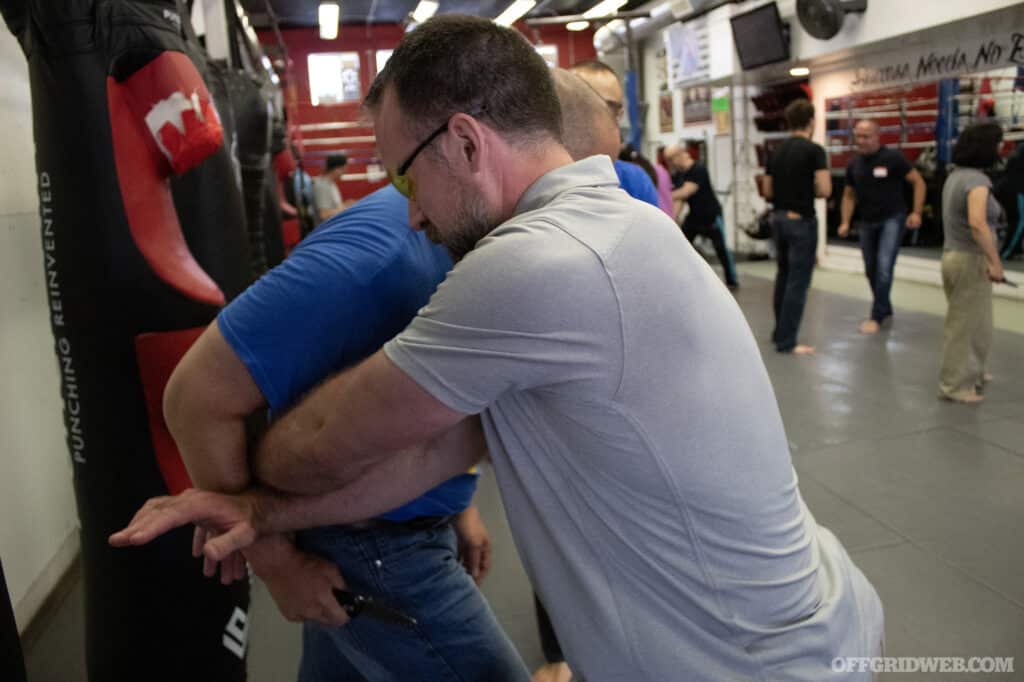
Above: The X-block is a quick and effective way to halt an initial knife stab.
From here it becomes a matter of locking the blade of the knife into a safe position by grabbing the wrist of the wielder and holding it in such a way that they have a difficult time getting loose. Mastering the X-block technique, we learned to neutralize both high and low knife thrusts.
Reposition: After the knife is in a position that will prevent you from getting severely cut, you'll need to move your own body into a place where you can strike your opponent. Ensuring there is no space between you and the attacker will prevent them from breaking loose or using a gap to strike through your defense. Secure the wrist, straighten those elbows, and keep the attacker beneath your center of gravity. If this procedure sounds intense, you are correct. Even practicing in a safe environment, it was shocking to experience first hand how quickly a situation can escalate.
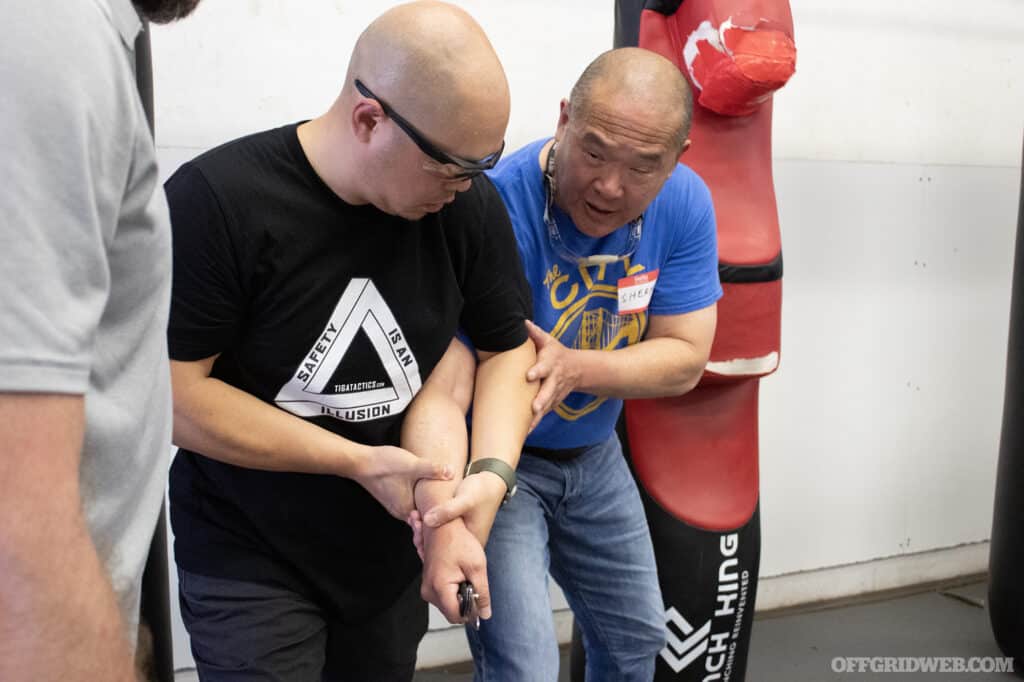
Above: By holding on tightly to the wrist, the knife cannot reach it's intended target.
Offense: Only after seizing control, did we switch into offense mode. Using the strikes from earlier, we attacked in a way meant to disable the attacker long enough to get away, or destroy their intent to harm.
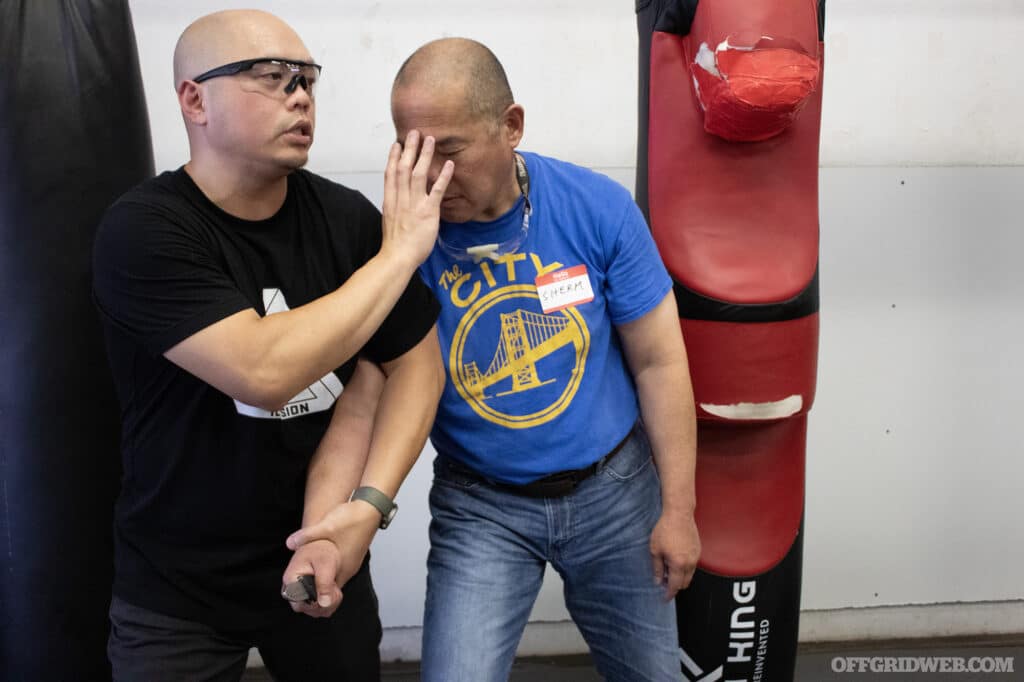
Above: Once the blade is secure, more energy can be spend on offensive strikes.
Having traversed the wild landscape of self-defense on day one, we were ready to delve deeper into the realm of knife defense and offense on day two. For the purposes of the Knife Defense Seminar, it means knowing how to deploy your own EDC knife to defend yourself from an aggravated assault.
Like detectives at a crime scene, we started with forensically analyzing videos of real-world attacks. Watching the videos left most of us unnerved, since the attackers seemed mentally ill and random, and it was easy to empathize with the plight of the victims. However, there was a silver lining. Each of the attackers had an obvious tell that would have given them away to the situationally aware observer. The hands, and the demeanor of the attackers in the videos leaked clues of an impending attack. This learning point was used as a segue to drive home how important mindset is, not just in self-defense, but as an everyday habit.
Above: People who attack with a knife typically use a few common methods, such as the overhand “psycho stab” demonstrated here.
Staying alert, using those environmental cues as reminders to calm your breathing and look around, has to be something practiced and developed. Not being a victim, or selected as a target, can be partially influenced by the choices we make. Hopefully, increasing this situational awareness gives you the upper hand when you do have to defend yourself, or go on the offensive. For those situations where a defender is not free to escape, such as when they find themselves in in a building or enclosed space, we bolstered our mental toolkit with the Four E's – Entry, Enemies, Escape, and Extinguishers.
Entry: Be aware of entry points, and the demeanor of those who pass through them.
Enemies: Keep a closer eye on people nearby who exhibit unstable mannerisms, who seem out of place, or clearly look like they are up to no good. Listen to your instincts.
Escape: Just as important as entry points, is to be aware of potential escape routes. This could be windows or utility doors. Avoid placing yourself in positions where you are boxed in to an unescapable corner.
Extinguishers: If the worst case scenario happens, being aware of where the fire extinguishers are can give you a surprising advantage. Extinguishers can be sprayed to obscure an attackers vision, or even used as a bludgeon.

Above: When entering a building or vehicle, try not to place yourself in a location with no escape routes.
Then came the crescendo—a gripping knife defense exam. We broke into two groups and launched into a mock battle, defending against each group member's knife attacks. Attacks were randomly left to fellow attendees to decide, either the low, underhand sewing machine attack, or the high, overhand psycho stab. It was as close to a real knife attack as we could simulate—a terrifying, yet eye-opening experience. Each person in the seminar practiced the PRO concepts against at least 10 other attendees under the sharp eyes of our instructors, testing our reactions and physical endurance. By the end of this exercise, a little sore and fatigued, we realized that every knife defense situation is different, and the only way to truly be ready for one is to maintain awareness, and continue training for the scenario in the future.
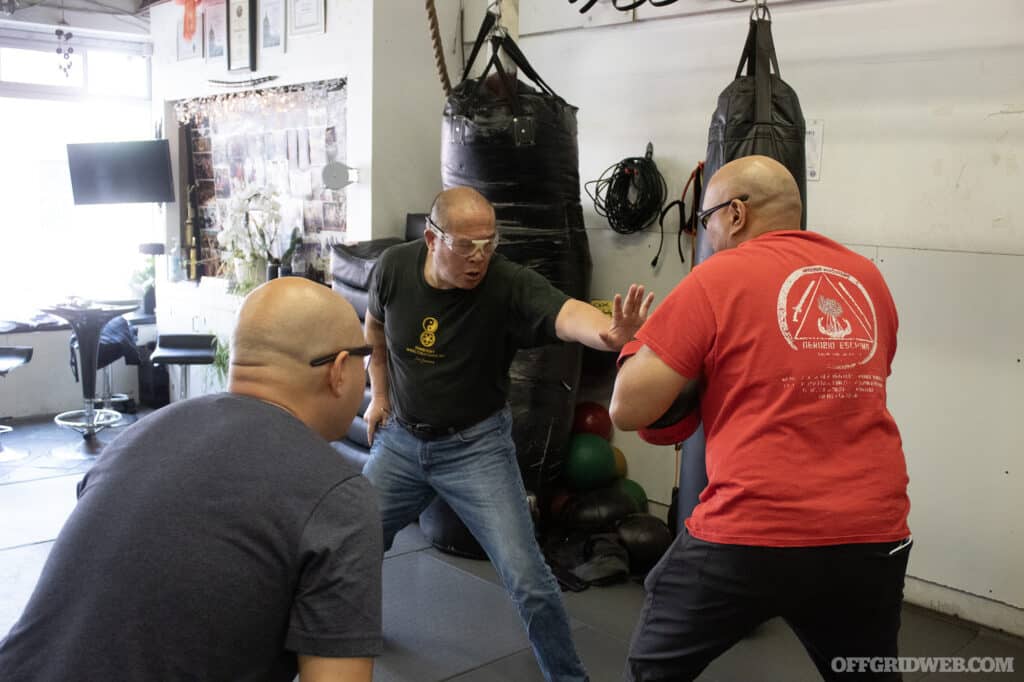
Above: Trying to draw a knife while being attacked requires a cool head and the proper technique.
Post-lunch, we moved into the complex maze of knife carrying laws. Whether or not we like to think about the legality of the situation, the truth of the matter is, if you have to defend yourself with or against a knife, you'll probably have to defend yourself in court. Following local knife laws could make or break the situation. Most places have laws regarding how you can carry a folding blade or fixed blade, how long your blade can be, and what style of blade you can carry. Being ignorant of these laws is not an excuse to disregard them, and can get you into trouble.
There was also the perception aspect of carrying a knife. Most people will have different emotional reactions depending on what style of blade they are looking at. For example, someone looking at the knife on a Leatherman Multi-Tool will react in a much different way to looking at a karambit. This emotional response will play a role in court. If you decide to carry a knife with a design that looks different from the generic “steak knife” look, be prepared to deal how people feel and potentially react to it.
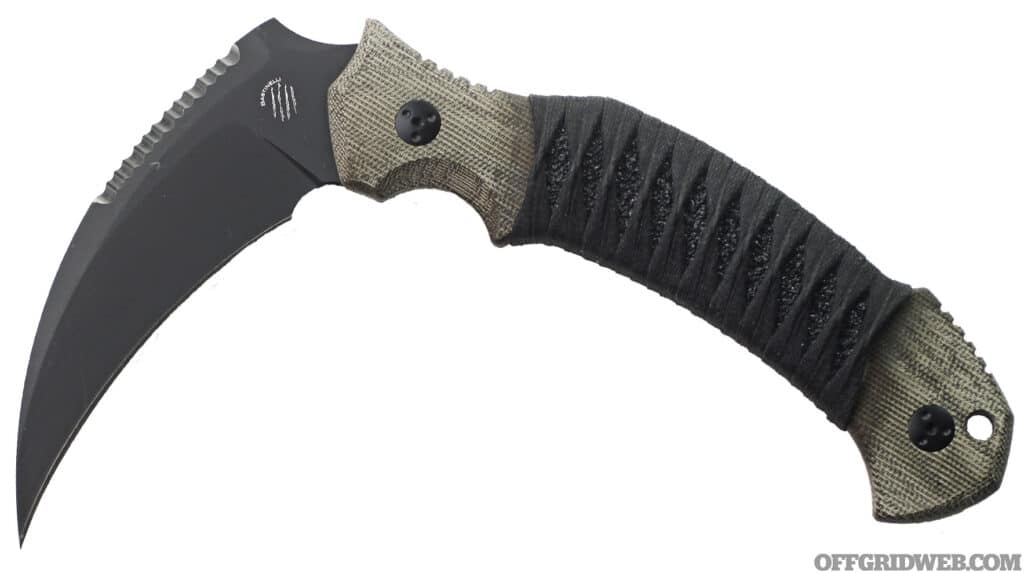
Above: Regardless of their real-world functionality, knives with unique designs can be perceived by the general public as more deadly than others with traditional designs.
We navigated through different carry positions—in the pocket, waistband, pocket clip, dangle sheath, or on the ankle. Each carry method has pros and cons related to ease of accessibility, as well as concealability. Legal restrictions aside, there is no right or wrong way to carry a knife, as long as it is carried consistently. Getting used to where the knife is located and how to access it will make the motions second nature. Consistent practice is the key here—you don't want to fumble when the moment arrives. One technique is to practice drawing the knife once per day whenever the knife is worn for the first time.
Drawing the knife isn't just an act—it's an art. From the ‘Stealth Draw' that keeps your knife hidden like a ninja, to the ‘Combat Draw', where your non-dominant hand plays defense while you unsheath your knife, we learned to adjust to the situation at hand.
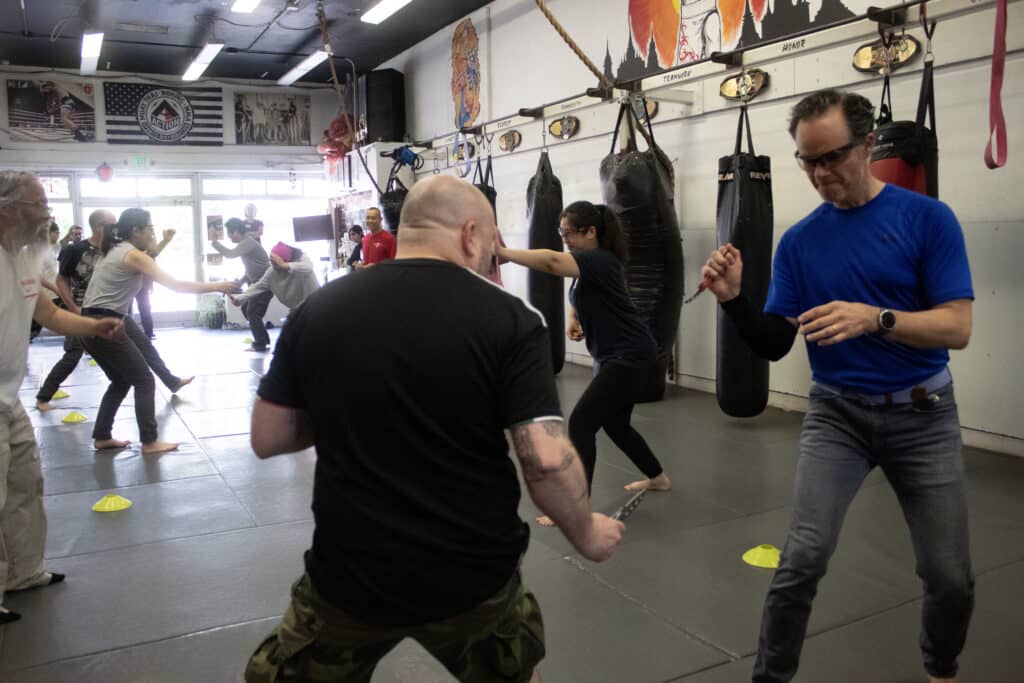
Above: How fast can you draw your knife? Facing off against another trying to do the same thing gives you an idea of how quickly a situation can escalate.
Stealth Draw: This is done by facing your opponent in such away that your blade is concealed the entire time you draw it. Motions are subtle. It should not be obvious to your aggressor that you are drawing a knife. The idea behind this is leveraging the element of surprise. If someone looks like they are intent on assaulting you, and all of a sudden a knife pops up out of nowhere, there is a strong chance they will change their mind.
Combat Draw: Using this technique is reserved for when the situation has already escalated into a full blown assault. You keep your attacker at bay with your non-dominant hand long enough to deploy your knife.
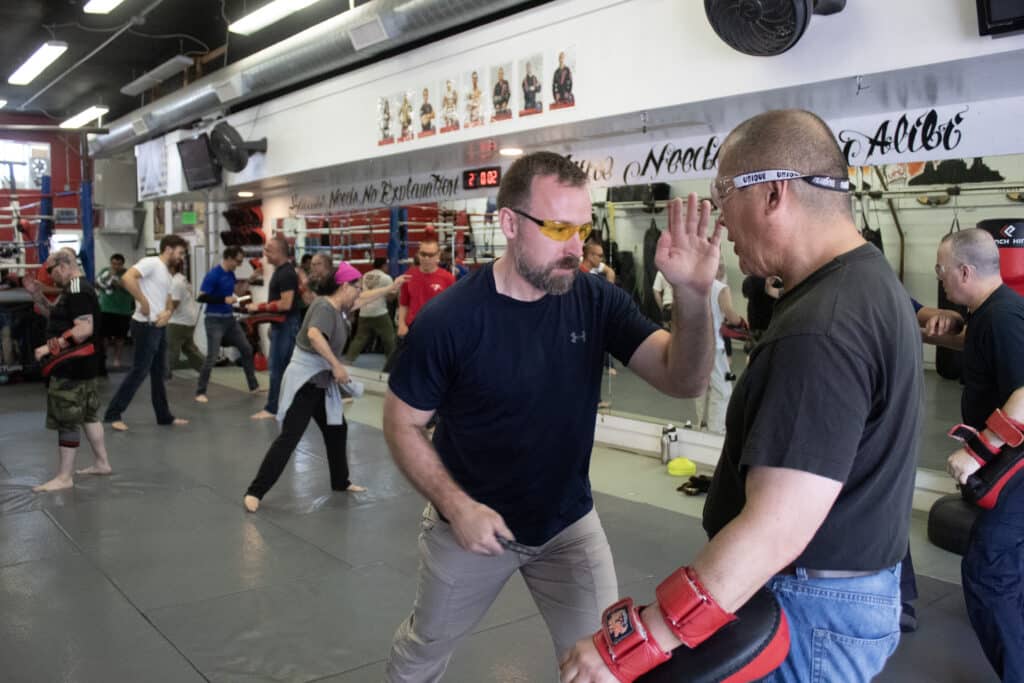
Above: Utilizing the Combat Draw will keep your attacker at bay while your own knife is being deployed.
In both situations, once the knife is deployed, you must make a choice as to how you will wield you blade. We discuss keeping movements simple. Hammer grip and diagonal slashes from shoulder to opposite hip, and combining with quick short thrusts, will effectively cut anything in front of you while minimizing the chances your knife will be knocked from your hand. These techniques should only be used long enough to convince your attacker that they made the wrong choice, or until you have a long enough window to escape.
Our two-day journey concluded with a profound revelation: you, yes, you are the weapon. The knife? That's just your sidekick, a tool that you can use as a force multiplier that increases your effectiveness as a weapon. With regular training, you ensure that the sidekick never upstages the hero—you.
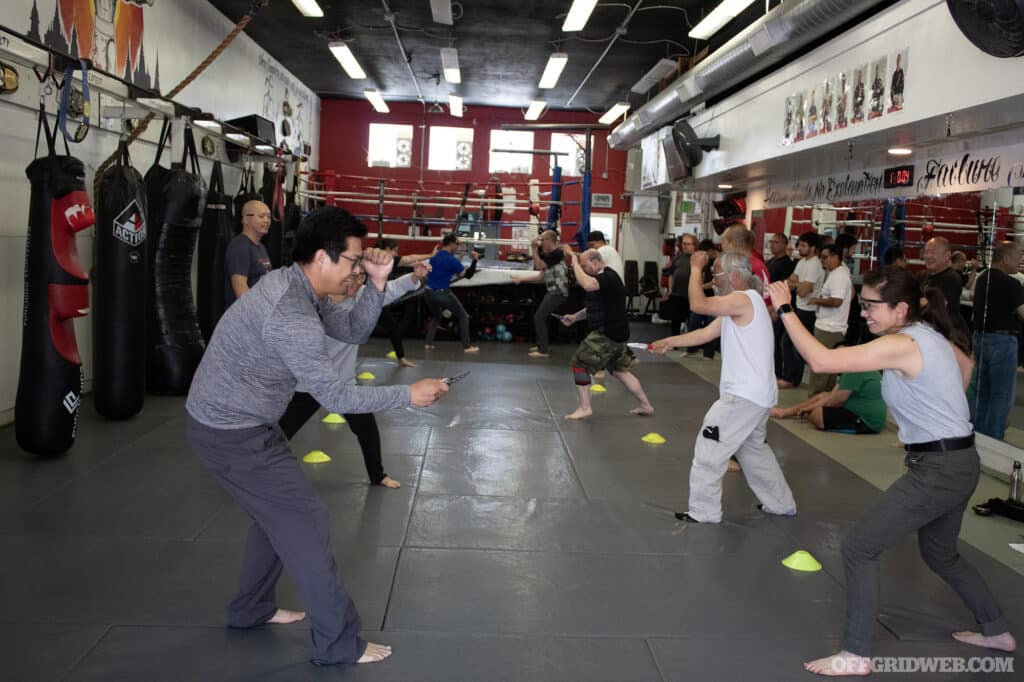
Above: Training should be effective, intense and fun. Tiga Tactics checked all of these blocks at the Knife Defense Seminar in San Francisco.
Are you ready to take a stand? To defend your life, or someone else's, if the situation demands? Can you choose to live, no matter what? That's the question we left with—a question that continues to echo in our minds as we step confidently into the world, armed with the knowledge that could one day save our lives.
 STAY SAFE: Download a Free copy of the OFFGRID Outbreak Issue
STAY SAFE: Download a Free copy of the OFFGRID Outbreak Issue
No Comments